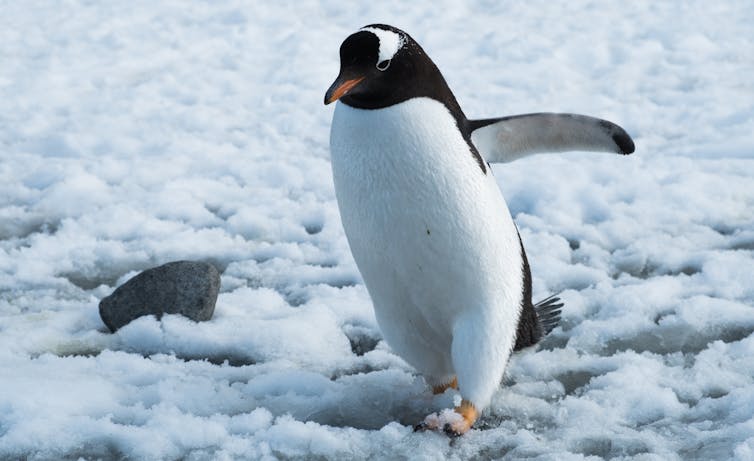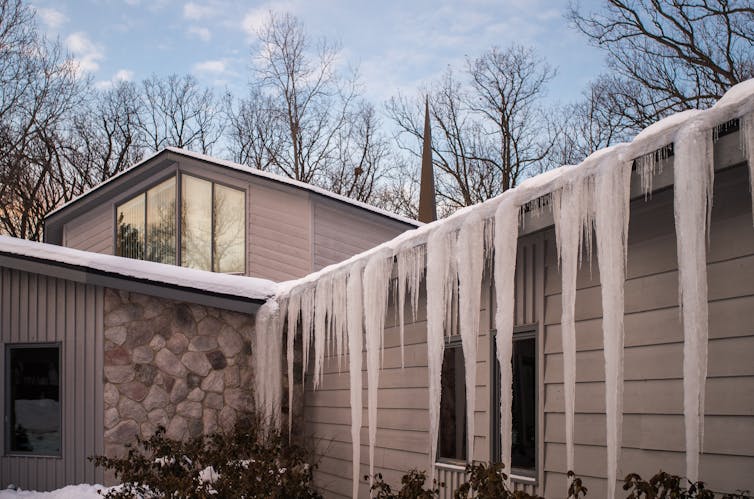Environment & Nature
Penguin feathers help inspire new de-icing techniques

The perpetually ice-free Gentoo penguin can serve as inspiration for the creation of passive anti-icing surfaces. (ravas51/flickr), CC BY-SA
Walking down a road during a white winter comes with its own set of challenges: the frigid cold, stepping around slippery ice on roads and the need to switch sidewalks to avoid dagger-sharp icicles that could potentially fall from above.
This accumulated ice on roofs and rain gutter overhangs is not merely an annoyance and danger, but also requires tremendous efforts to remove. Standard ice removal techniques rely on mechanical, thermal or chemical action.
The ice on road signs, electrical transmission pylons and cables is removed by hitting the ice slabs to induce vibrations to the object or by bending the structure.
Airplanes are sprayed with de-icing fluids that chemically melt and prevent the formation of ice before take-off. And like heated sidewalks, airplane wings are typically heated in flight to melt ice that can form on their leading edges.
While all these anti-icing approaches are necessary to avoid fatal infrastructure failure and accidents, these techniques are unsustainable as they require tremendous amounts of energy and harmful chemicals. Over the past few decades, researchers have tried to develop passive anti-icing technology — a surface that would not allow ice to form on it or would require very little effort to dislodge any small inconsequential pieces of ice that did.
Our team of researchers at McGill University’s Biomimetic Surface Engineering Laboratory looked to nature for these solutions. Nature takes a different approach to solving its icy surface problems. Through millennia, species have adapted to possess an array of surface functions that do not require harsh chemistry or huge amounts of energy input. We found the solution to de-icing challenges in the feathers of adorable wobble-gaited penguins.
Reading between the feathers
When we set out to develop a passive anti-icing surface last winter, we thought about how penguins have never been photographed with a big ice crust on their plumage, despite living in really cold environments, swimming and hunting in frigid waters and standing in high winds.
We contacted the Montréal Biodome — which showcases different ecosystems — and visited their sub-Antarctic exhibit with Gentoo penguins. They also gave us a jar full of shed Gentoo feathers.
We studied the microstructure and wetting behaviour of individual feathers and also reassembled them into a feather mat to study whether or not they attract ice. Wetting behaviour characterizes how water droplets behave on the surface. Basically, it checks whether droplets roll off like tiny soccer balls or spread out in a puddle or whether the outcome is something in between.
Our analysis showed that the penguin’s plumage has both water-shedding and ice-shedding properties. The preening oil that the bird applies when it grooms itself did not appear to play a role in ice-shedding. This led us to suspect that these effects come from the structure of its feathers, which meant that the structure of penguin feathers could provide a radically different approach to creating surface designs with passive anti-icing properties.
The detailed features of every individual feather and the role of the hamuli — a part of the feather that hooks individual feathers together into a mat — inspired us to replicate this natural wire-like mesh of a structure using woven textiles.
In order to mimic the microstructure of the penguin feathers we observed, we selected stainless steel cloths with wire diameters and pore sizes similar to those of the feathers. We also used our ultrafast laser processing equipment to match the longitudinal nano-sized grooves seen on the barbs and barbules of the penguin feather’s structure.
Creating water- and ice- repelling surfaces
Our research found that while a water-repellent surface is a definite requirement for stainless steel mesh cloth to shed water, this requirement becomes less important as the temperature decreases.
This is because water actually penetrates the previously empty mesh pores and freezes slowly as the temperatures drop low, creating cracks in the ice surface. This means that the surface can easily repel water and ice at freezing temperatures.

Biomimetic mesh surfaces, which mimic penguin feathers with a woven stainless steel textile, showed about 95 per cent decreased ice adhesion strength compared to polished smooth monolithic stainless steel surfaces. (MiriaGrunick/flickr), CC BY-NC-SA
This is in contrast to the majority of water-repellant surfaces that mimic air-trapping as seen in lotus leaves (lotus effect), where water penetration often strengthens the adhesion of ice.
Our biomimetic mesh surfaces — which mimicked penguin feathers with a woven stainless steel textile — showed about 95 per cent decreased ice adhesion strength compared to polished smooth monolithic stainless steel.
This extremely good ice-shedding performance can be attributed to the shape of the microstructure pores, the openings of which are smaller than the actual empty space inside the pore.
These pore openings get closed off first by growing ice, which traps still liquid water inside. That enclosed water freezes slowly in comparison to the water on the outside. As it freezes, it can expand by around nine per cent in its confined space, ultimately creating cracks along every single pore of the wire cloth. These cracks help any ice build up to shed off easily.
A de-icing strategy for the future
While our study approaches the problem of ice accumulation from a different perspective than all previous studies, it provides potential new de-icing solutions to a problem that affects our lives every winter.

De-icing techniques that mimic penguin feather structures can be used alongside heating systems to prevent icicle formation on house roofs. (Andrew Seaman/flickr), CC BY-ND
Clearly, we need more investigations and developments before critical infrastructure such as aircraft or power lines solely rely on passive de-icing solutions like these.
However, we can implement them alongside traditional active heating systems for less-critical applications like street signs in the foreseeable future. This will allow us to investigate the long-term stability of such textured surfaces, their installation and maintenance costs, and whether or not it curbs the energy and chemical requirements of today’s de-icing techniques.![]()
Anne-Marie Kietzig, Associate Professor, Department of Chemical Engineering, McGill University and Michael John Wood, Mitacs Elevate Post-Doctoral Scholar, McGill University
This article is republished from The Conversation under a Creative Commons license. Read the original article.





















